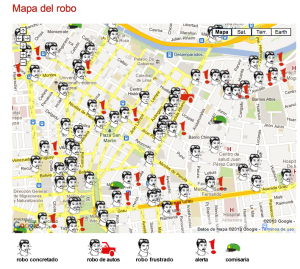Crowdsourcing can be very useful in disaster response, as we have learned from our OpenStreetMap project. It provides humanitarian actors such as the Red Cross to obtain accurate information on affected areas in times of need, when traditional mapping is insufficient. However, crowdsourced maps have other uses as well. In Lima, Peru, a site entitled Que No Te Roben maps the location and manner of crimes throughout the city. It pinpoints successful robberies, escaped robberies, crime warnings, and car robberies. The map also has the locations of police offices where crimes can be reported. This map can serve as a fast and simple avenue for communication between citizens and the city police. By looking at the pins, citizens know where is safe, as well as where to report crimes. Police can also benefit from the map by identifying problem areas with high robbery rates.
The makers of this website not only use crowdsourced mapping to educate on crime in Lima, but also social media. They also run a youtube channel, a Facebook page, and a twitter account that all disseminate information on how to avoid becoming a victim of crime. The Facebook page has garnered about 3200 likes since it joined in March of 2010, and its Twitter has about 1500 followers since the same date. Considering that the population of Lima comes in at about 7 million people, the initiative has a long ways to go before these social media initiatives truly benefit the city as a whole. This initiative demonstrates another angle in which crowdsourced material and social media can be used to spread useful information to members of society, but also shows the challenges of becoming well known enough to effectively get the message out.

April 5th, 2013 at 2:55 pm
This is very interesting and a great application of crowdsourcing! It is cool since there is a similar mapping of crime right here in New Orleans that Tulane has made.
April 11th, 2013 at 4:04 pm
Very interesting idea, definitely brings awareness to the problem of robberies and insecurity in Latin America. However, is there any information on the follow-up actions to the crimes reported. Such as criminals successfully caught that were reported? I ask this because I know from personal experience that only a small number of crimes are actually solved in most parts of Latin America and it would be amazing if crowdsourcing could help to solve more of these crimes.